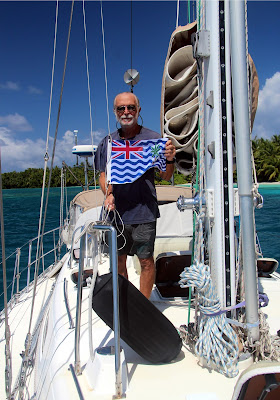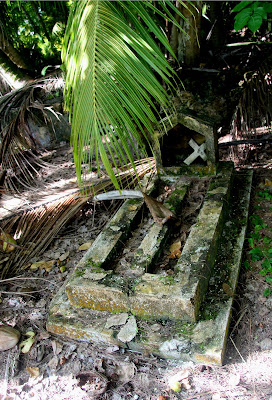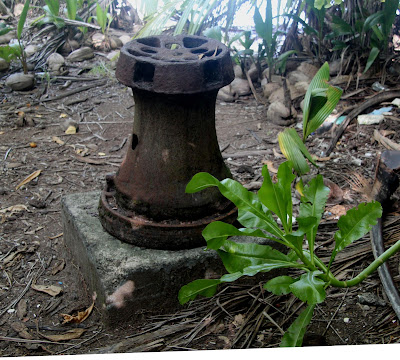Sunrise on our approach to Chagos
You can see one of the islands that make up the Salomon Atoll on the horizon.
As we got closer to Chagos (also known as British Indian Ocean Teritory or BIOT) the seabirds began to show us the way - who needs GPS? Chagos is really a pretty magical place. It's about as remote as you will get when it comes to tropical atolls. Being completely uninhabited is an alluring plus. And for me the highlight is the left over rusty stuff from the copra plantation and the previous, now exiled, population. The United Kingdom evicted the Chagossians between 1967 and 1971, including about 50 from Boddham in the neighboring Salomon Atoll. The atolls are corraline structures topping a submarine ridge that was volcanically formed by the Reunion Hotspot in the center of the Indian Ocean (at least that's what Wikipeda thinks). Chagos contains the world's largest coral atoll. The atoll that we spent our time on, Salomon, is about 13.8 sq miles of total area that contains about 1.4 sq miles of land. The entire area has been a marine reserve no-take zone since 2010 --- not counting the poaching.
The early Maldivians knew of the Chagos islands, but they were too far away for them to care much about them. The Portuguese discovered them in 1512 or 1532 or there abouts. They were named after the holy wounds of Jesus -- chagas being wound in Portuguese. The French began issuing permits for coconut plantations in 1770s. In 1793 the first colony was successfully created under British rule, using slave labor imported from Africa until 1840. An earlier blog goes into a little bit on who should own Chagos now.
When we arrived our friends Matt, Jenn and kids Conrad and Mark on SV Perry stopped by. They were the only other boat in Chagos. They brought along the black tip shark you see in the background. these sharks were our constant companions while there.
Putting our British Indian Ocean Territories courtesy flag up. But, now that the courts say the islands should belong to Mauritius instead of he UK, maybe it's not appropriate.
There are two places to moor when in the Salomon Atoll, Boddham and Fouquet. Fouquet has a couple of wide, sandy areas to anchor. Boddham is covered with coral bommies and has no place to put down anchor. There are many old moorings chained around bommies that were left from cruisers over the years. We picked up this one. The upper picture is the heavy, coral encrusted line tied to the bow of Georgia. The lower picture is he bommie that this line is chained to. After tying up and backing down on this mooring to test its strength, we took our stern anchor rode, made a loop with the chain and shackle, dropped this over a near by bommie as a backup. (05*21.212S,072*012.468E)
Looking at Boddham Is. from the anchorage you'd never know how many old buildings there are on the skinny island. About center of this picture is the remains of the old, rock landing pier. The island is about 500 m (1,600 ft) wide at this point.
Just a reminder where we are in the middle of the Indian Ocean
In the old days, when cruisers were allowed to visit Chagos and stay as long as they wanted, there were a group of modern day Robinson Crusoe wannabes who spent half a year or more at a time in Chagos. This was the Yacht Club.
The old buildings from the copra plantation are now overrun by jungle and coconut trees.
The most notable residents of Chagos are the coconut crabs.
The church was built in 1932.
A closer view of the neo-gothic, Catholic church.
Your blog hosts braving a large coconut crab walking up a coconut tree -- just to deliver this adventure picture. Notice who is closer to the man-eating crab (ok, actually they are strict vegetarians. They are the largest terrestrial arthropod and can weigh up to 9 lbs and get to 3 ft leg tip to leg tip).
The settlement wells are still full of fresh water.
The cemetery is in a large clearing. Lots of cement graves but no readable tombstones.
It's a shame that the tombstones are not readable.
Coconut crab enjoying it's namesake treat.
(Part 2 of Chagos includes the underwater shots)
Paul


























No comments:
Post a Comment